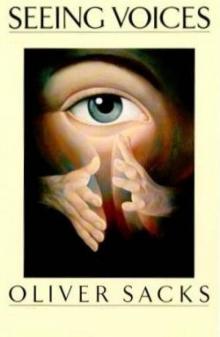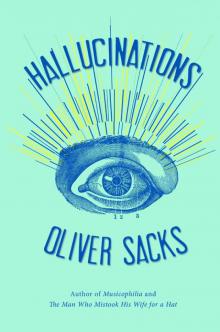- Home
- Oliver Sacks
Hallucinations
Hallucinations Read online
THIS IS A BORZOI BOOK
PUBLISHED BY ALFRED A. KNOPF AND
ALFRED A. KNOPF CANADA
Copyright © 2012 by Oliver Sacks, M.D.
All rights reserved. Published in the United States by Alfred A. Knopf, a division of Random House, Inc., New York, and in Canada by Alfred A. Knopf Canada, a division of Random House of Canada Limited, Toronto.
www.aaknopf.com
www.randomhouse.ca
Knopf, Borzoi Books, and the colophon are registered trademarks of Random House, Inc.
Knopf Canada and colophon are trademarks.
Owing to limits of space, permissions acknowledgments may be found following.
Library of Congress Cataloging-in-Publication Data Sacks, Oliver W.
Hallucinations / Oliver Sacks. — 1st American ed.
p.; cm.
Includes bibliographical references.
I. Title.
[DNLM: 1. Hallucinations. 2. Perceptual Disorders. WM 204]
616.89–dc23 2012002877
Library and Archives Canada Cataloguing in Publication Sacks, Oliver W.
Hallucinations / Oliver Sacks.
eISBN: 978-0-307-95725-2
1. Hallucinations and illusions. 2. Perceptual disorders. I. Title.
RC553.H3S23 2012 616.89 C2012-902091-5
www.oliversacks.com
Cover design by Hailey Wojcik
v3.1
For Kate
Contents
Cover
Title Page
Copyright
Dedication
Introduction
1. Silent Multitudes: Charles Bonnet Syndrome
2. The Prisoner’s Cinema: Sensory Deprivation
3. A Few Nanograms of Wine: Hallucinatory Smells
4. Hearing Things
5. The Illusions of Parkinsonism
6. Altered States
7. Patterns: Visual Migraines
8. The “Sacred” Disease
9. Bisected: Hallucinations in the Half-Field
10. Delirious
11. On the Threshold of Sleep
12. Narcolepsy and Night Hags
13. The Haunted Mind
14. Doppelgängers: Hallucinating Oneself
15. Phantoms, Shadows, and Sensory Ghosts
Acknowledgments
Bibliography
Permissions Acknowledgments
A Note About the Author
Other Books by This Author
Introduction
When the word “hallucination” first came into use, in the early sixteenth century, it denoted only “a wandering mind.” It was not until the 1830s that Jean-Étienne Esquirol, a French psychiatrist, gave the term its present meaning—prior to that, what we now call hallucinations were referred to simply as “apparitions.” Precise definitions of the word “hallucination” still vary considerably, chiefly because it is not always easy to discern where the boundary lies between hallucination, misperception, and illusion. But generally, hallucinations are defined as percepts arising in the absence of any external reality—seeing things or hearing things that are not there.1
Perceptions are, to some extent, shareable—you and I can agree that there is a tree; but if I say, “I see a tree there,” and you see nothing of the sort, you will regard my “tree” as a hallucination, something concocted by my brain or mind, and imperceptible to you or anyone else. To the hallucinator, though, hallucinations seem very real; they can mimic perception in every respect, starting with the way they are projected into the external world.
Hallucinations tend to be startling. This is sometimes because of their content—a gigantic spider in the middle of the room or tiny people six inches tall—but, more fundamentally, it is because there is no “consensual validation”; no one else sees what you see, and you realize with a shock that the giant spider or the tiny people must be “in your head.”
When you conjure up ordinary images—of a rectangle, or a friend’s face, or the Eiffel Tower—the images stay in your head. They are not projected into external space like a hallucination, and they lack the detailed quality of a percept or a hallucination. You actively create such voluntary images and can revise them as you please. In contrast, you are passive and helpless in the face of hallucinations: they happen to you, autonomously—they appear and disappear when they please, not when you please.
There is another mode of hallucination, sometimes called pseudo-hallucination, in which hallucinations are not projected into external space but are seen, so to speak, on the inside of one’s eyelids—such hallucinations typically occur in near-sleep states, with closed eyes. But these inner hallucinations have all the other hallmarks of hallucinations: they are involuntary, uncontrollable, and may have preternatural color and detail or bizarre forms and transformations, quite unlike normal visual imagery.
Hallucinations may overlap with misperceptions or illusions. If, looking at someone’s face, I see only half a face, this is a misperception. The distinction becomes less clear with more complex situations. If I look at someone standing in front of me and see not a single figure but five identical figures in a row, is this “polyopia” a misperception or a hallucination? If I see someone cross the room from left to right, then see them crossing the room in precisely the same way again and again, is this sort of repetition (a “palinopsia”) a perceptual aberration, a hallucination, or both? We tend to speak of such things as misperceptions or illusions if there is something there to begin with—a human figure, for example—whereas hallucinations are conjured out of thin air. But many of my patients experience outright hallucinations, illusions, and complex misperceptions, and sometimes the line between these is difficult to draw.
Though the phenomena of hallucination are probably as old as the human brain, our understanding of them has greatly increased over the last few decades.2 This new knowledge comes especially from our ability to image the brain and to monitor its electrical and metabolic activities while people are hallucinating. Such techniques, coupled with implanted-electrode studies (in patients with intractable epilepsy who need surgery), have allowed us to define which parts of the brain are responsible for different sorts of hallucinations. For instance, an area in the right inferotemporal cortex normally involved in the perception of faces, if abnormally activated, may cause people to hallucinate faces. There is a corresponding area on the other side of the brain normally employed in reading—the visual word form area in the fusiform gyrus; if this is abnormally stimulated, it may give rise to hallucinations of letters or pseudowords.
Hallucinations are “positive” phenomena, as opposed to the negative symptoms, the deficits or losses caused by accident or disease, which neurology is classically based on. The phenomenology of hallucinations often points to the brain structures and mechanisms involved and can therefore, potentially, provide more direct insight into the workings of the brain.
Hallucinations have always had an important place in our mental lives and in our culture. Indeed, one must wonder to what extent hallucinatory experiences have given rise to our art, folklore, and even religion. Do the geometric patterns seen in migraine and other conditions prefigure the motifs of Aboriginal art? Did Lilliputian hallucinations (which are not uncommon) give rise to the elves, imps, leprechauns, and fairies in our folklore? Do the terrifying hallucinations of the night-mare, being ridden and suffocated by a malign presence, play a part in generating our concepts of demons and witches or malignant aliens? Do “ecstatic” seizures, such as Dostoevsky had, play a part in generating our sense of the divine? Do out-of-body experiences allow the feeling that one can be disembodied? Does the substancelessness of hallucinations encourage a belief in ghosts and spirits? Why has every culture known to us sought and found hallucinogenic dr
ugs and used them, first and foremost, for sacramental purposes?
This is not a new thought—in 1845, Alexandre Brierre de Boismont, in the first systematic medical book on the subject, explored such ideas in a chapter titled “Hallucinations in Relation to Psychology, History, Morality, and Religion.” Anthropologists including Weston La Barre and Richard Evans Schultes, among others, have documented the role of hallucinations in societies around the globe.3 Time has only broadened and deepened our appreciation of the great cultural importance of what might at first seem to be little more than a neurological quirk.
I will say very little in this book about the vast and fascinating realm of dreams (which, one can argue, are hallucinations of a sort), other than to touch on the dreamlike quality of some hallucinations and on the “dreamy states” which occur in some seizures. Some have proposed a continuum of dream states and hallucinations (and this may be especially so with hypnagogic and hypnopompic hallucinations), but, in general, hallucinations are quite unlike dreams.
Hallucinations often seem to have the creativity of imagination, dreams, or fantasy—or the vivid detail and externality of perception. But hallucination is none of these, though it may share some neurophysiological mechanisms with each. Hallucination is a unique and special category of consciousness and mental life.
The hallucinations often experienced by people with schizophrenia also demand a separate consideration, a book of their own, for they cannot be divorced from the often profoundly altered inner life and life circumstances of those with schizophrenia. So I will refer relatively little to schizophrenic hallucinations here, focusing instead on the hallucinations that can occur in “organic” psychoses—the transient psychoses sometimes associated with delirium, epilepsy, drug use, and certain medical conditions.
Many cultures regard hallucination, like dreams, as a special, privileged state of consciousness—one that is actively sought through spiritual practices, meditation, drugs, or solitude. But in modern Western culture, hallucinations are more often considered to portend madness or something dire happening to the brain—even though the vast majority of hallucinations have no such dark implications. There is great stigma here, and patients are often reluctant to admit to hallucinating, afraid that their friends and even their doctors will think they are losing their minds. I have been very fortunate that, in my own practice and in correspondence with readers (which I think of, in some ways, as an extension of my practice), I have encountered so many people willing to share their experiences. Many of them have expressed the hope that telling their stories will help defuse the often cruel misunderstandings which surround the whole subject.
I think of this book, then, as a sort of natural history or anthology of hallucinations, describing the experiences and impact of hallucinations on those who have them, for the power of hallucinations is only to be understood from firstperson accounts.
Some of the chapters that follow are organized by medical categories (blindness, sensory deprivation, narcolepsy, etc.), and others are organized by sensory modality (hearing things, smelling things, etc.). But there is a great deal of overlap and interconnection between these categories, and similar hallucinations may occur in a wide variety of conditions. Here, then, is a sampling which I hope will give a sense of the great range, the varieties, of hallucinatory experience, an essential part of the human condition.
1. My own favorite definition is that given by William James in his 1890 Principles of Psychology: “An hallucination is a strictly sensational form of consciousness, as good and true a sensation as if there were a real object there. The object happens to be not there, that is all.” Many other researchers have proposed their own definitions, and Jan Dirk Blom, in his encyclopedic Dictionary of Hallucinations, includes dozens of these.
2. We cannot be certain whether other animals have hallucinations, although “hallucinatory behaviors” have been observed in laboratory animals as well as in natural settings, as Ronald K. Siegel and Murray E. Jarvik described in their review of the subject.
3. La Barre provided an extended review of anthropological perspectives on hallucination in a chapter published in 1975.
1
Silent Multitudes: Charles Bonnet Syndrome
One day late in November 2006, I got an emergency phone call from a nursing home where I work. One of the residents, Rosalie, a lady in her nineties, had suddenly started seeing things, having odd hallucinations which seemed overwhelmingly real. The nurses had called the psychiatrist in to see her, but they also wondered whether the problem might be something neurological—Alzheimer’s, perhaps, or a stroke.
When I arrived and greeted her, I was surprised to realize that Rosalie was completely blind—the nurses had said nothing about this. Though she had not seen anything at all for several years, she was now “seeing” things, right in front of her.
“What sort of things?” I asked.
“People in Eastern dress!” she exclaimed. “In drapes, walking up and down stairs … a man who turns towards me and smiles, but he has huge teeth on one side of his mouth. Animals, too. I see this scene with a white building, and it is snowing—a soft snow, it is swirling. I see this horse (not a pretty horse, a drudgery horse) with a harness, dragging snow away … but it keeps switching.… I see a lot of children; they’re walking up and down stairs. They wear bright colors—rose, blue—like Eastern dress.” She had been seeing such scenes for several days.
I observed with Rosalie (as with many other patients) that while she was hallucinating, her eyes were open, and even though she could see nothing, her eyes moved here and there, as if looking at an actual scene. It was that which had first caught the nurses’ attention. Such looking or scanning does not occur with imagined scenes; most people, when visualizing or concentrating on their internal imagery, tend to close their eyes or else to have an abstracted gaze, looking at nothing in particular. As Colin McGinn brings out in his book Mindsight, one does not hope to discover anything surprising or novel in one’s own imagery, whereas hallucinations may be full of surprises. They are often much more detailed than imagery, and ask to be inspected and studied.
Her hallucinations, Rosalie said, were more “like a movie” than a dream; and like a movie, they sometimes fascinated her, sometimes bored her (“all that walking up and down, all that Eastern dress”). They came and went, and seemed to have nothing to do with her. The images were silent, and the people she saw seemed to take no notice of her. Apart from their uncanny silence, these figures seemed quite solid and real, though sometimes two-dimensional. But she had never before experienced anything like this, so she could not help wondering: was she losing her mind?
I questioned Rosalie carefully but found nothing suggestive of confusion or delusion. Looking into her eyes with an ophthalmoscope, I could see the devastation of her retinas but nothing else amiss. Neurologically, she was completely normal—a strong-minded old lady, very vigorous for her years. I reassured her about her brain and mind; she seemed, indeed, to be quite sane. I explained to her that hallucinations, strangely, are not uncommon in those with blindness or impaired sight, and that these visions are not “psychiatric” but a reaction of the brain to the loss of eyesight. She had a condition called Charles Bonnet syndrome.
Rosalie digested this and said she was puzzled as to why she had started having hallucinations now, after being blind for several years. But she was very pleased and reassured to be told that her hallucinations represented a recognized condition, one that even had a name. She drew herself up and said, “Tell the nurses—I have Charles Bonnet syndrome.” Then she asked, “Who was this Charles Bonnet?”
Charles Bonnet was an eighteenth-century Swiss naturalist whose investigations ranged broadly, from entomology to reproduction and regeneration in polyps and other animalcules. When an eye disease made his beloved microscopy impossible, he turned to botany—he did pioneer experiments on photosynthesis—then to psychology, and finally to philosophy. When he heard that his grandfather Charle
s Lullin had started to have “visions” as his eyesight failed, Bonnet asked him to dictate a full account.
John Locke, in his 1690 Essay Concerning Human Understanding, put forward the notion that the mind is a tabula rasa until it receives information from the senses. This “sensationalism,” as it was called, was very popular with the philosophes and rationalists of the eighteenth century, including Bonnet. Bonnet also conceived of the brain as “an organ of intricate composition, or rather an assemblage of different organs.” These different “organs” all had their own dedicated functions. (Such a modular view of the brain was radical at the time, for the brain was still widely regarded as undifferentiated, uniform in structure and function.) Thus Bonnet attributed his grandfather’s hallucinations to continuing activity in what he postulated were visual parts of the brain—an activity drawing on memory now that it could no longer draw on sensation.
Bonnet—who would later experience similar hallucinations when his own eyesight declined—published a brief account of Lullin’s experiences in his 1760 Essai analytique sur les facultés de l’âme, a book devoted to considering the physiological basis of various senses and mental states, but Lullin’s original account, which filled eighteen pages of a notebook, was subsequently lost for nearly 150 years, coming to light only at the beginning of the twentieth century. Douwe Draaisma has recently translated Lullin’s account, including it in a detailed history of Charles Bonnet syndrome in his book Disturbances of the Mind.1
Unlike Rosalie, Lullin still had some eyesight left, and his hallucinations were superimposed on what he saw in the real world. Draaisma summarized Lullin’s account:
In February 1758, strange objects had begun to float into his field of vision. It started with something that resembled a blue handkerchief, with a small yellow circle in each corner.… The handkerchief followed the movement of his eyes: whether he was looking at a wall, his bed, or a tapestry, the handkerchief blocked out all the ordinary objects in his room. Lullin was perfectly lucid and at no time did he believe that there really was a blue handkerchief floating around.…

 Uncle Tungsten
Uncle Tungsten Oaxaca Journal
Oaxaca Journal Musicophilia
Musicophilia The man who mistook his wife for a hat
The man who mistook his wife for a hat 1989 - Seeing Voices
1989 - Seeing Voices On the Move: A Life
On the Move: A Life 1996 - The Island of the Colorblind
1996 - The Island of the Colorblind An Anthropologist on Mars: Seven Paradoxical Tales
An Anthropologist on Mars: Seven Paradoxical Tales Hallucinations
Hallucinations Seeing Voices
Seeing Voices The River of Consciousness
The River of Consciousness Vintage Sacks
Vintage Sacks The Mind's Eye
The Mind's Eye Everything in Its Place
Everything in Its Place An Anthropologist on Mars (1995)
An Anthropologist on Mars (1995) Uncle Tungsten: Memories of a Chemical Boyhood (2001)
Uncle Tungsten: Memories of a Chemical Boyhood (2001)